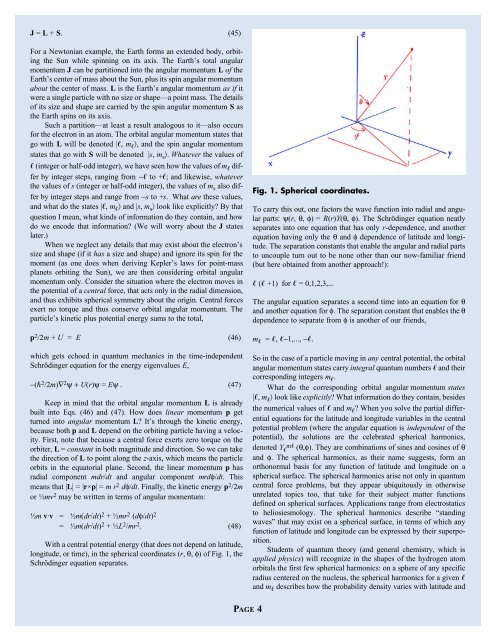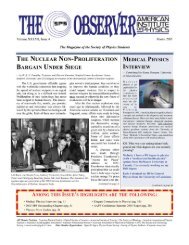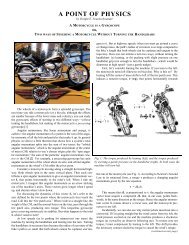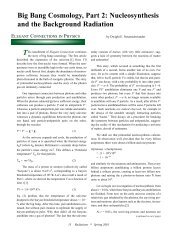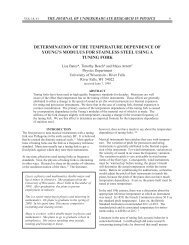Elegant Connections in Physics: Quantized Angular Momentum, 'g ...
Elegant Connections in Physics: Quantized Angular Momentum, 'g ...
Elegant Connections in Physics: Quantized Angular Momentum, 'g ...
You also want an ePaper? Increase the reach of your titles
YUMPU automatically turns print PDFs into web optimized ePapers that Google loves.
J = L + S. (45)<br />
For a Newtonian example, the Earth forms an extended body, orbit<strong>in</strong>g<br />
the Sun while sp<strong>in</strong>n<strong>in</strong>g on its axis. The Earth’s total angular<br />
momentum J can be partitioned <strong>in</strong>to the angular momentum L of the<br />
Earth’s center of mass about the Sun, plus its sp<strong>in</strong> angular momentum<br />
about the center of mass. L is the Earth’s angular momentum as if it<br />
were a s<strong>in</strong>gle particle with no size or shape—a po<strong>in</strong>t mass. The details<br />
of its size and shape are carried by the sp<strong>in</strong> angular momentum S as<br />
the Earth sp<strong>in</strong>s on its axis.<br />
Such a partition—at least a result analogous to it—also occurs<br />
for the electron <strong>in</strong> an atom. The orbital angular momentum states that<br />
go with L will be denoted |, m &, and the sp<strong>in</strong> angular momentum<br />
states that go with S will be denoted |s, m s &. Whatever the values of<br />
(<strong>in</strong>teger or half-odd <strong>in</strong>teger), we have seen how the values of m differ<br />
by <strong>in</strong>teger steps, rang<strong>in</strong>g from − to +; and likewise, whatever<br />
the values of s (<strong>in</strong>teger or half-odd <strong>in</strong>teger), the values of m s also differ<br />
by <strong>in</strong>teger steps and range from −s to +s. What are these values,<br />
and what do the states |, m & and |s, m s & look like explicitly? By that<br />
question I mean, what k<strong>in</strong>ds of <strong>in</strong>formation do they conta<strong>in</strong>, and how<br />
do we encode that <strong>in</strong>formation? (We will worry about the J states<br />
later.)<br />
When we neglect any details that may exist about the electron’s<br />
size and shape (if it has a size and shape) and ignore its sp<strong>in</strong> for the<br />
moment (as one does when deriv<strong>in</strong>g Kepler’s laws for po<strong>in</strong>t-mass<br />
planets orbit<strong>in</strong>g the Sun), we are then consider<strong>in</strong>g orbital angular<br />
momentum only. Consider the situation where the electron moves <strong>in</strong><br />
the potential of a central force, that acts only <strong>in</strong> the radial dimension,<br />
and thus exhibits spherical symmetry about the orig<strong>in</strong>. Central forces<br />
exert no torque and thus conserve orbital angular momentum. The<br />
particle’s k<strong>in</strong>etic plus potential energy sums to the total,<br />
p 2 /2m + U = E (46)<br />
which gets echoed <strong>in</strong> quantum mechanics <strong>in</strong> the time-<strong>in</strong>dependent<br />
Schröd<strong>in</strong>ger equation for the energy eigenvalues E,<br />
−(\ 2 /2m)∇ 2 ψ + U(r)ψ = Eψ . (47)<br />
Keep <strong>in</strong> m<strong>in</strong>d that the orbital angular momentum L is already<br />
built <strong>in</strong>to Eqs. (46) and (47). How does l<strong>in</strong>ear momentum p get<br />
turned <strong>in</strong>to angular momentum L? It’s through the k<strong>in</strong>etic energy,<br />
because both p and L depend on the orbit<strong>in</strong>g particle hav<strong>in</strong>g a velocity.<br />
First, note that because a central force exerts zero torque on the<br />
orbiter, L = constant <strong>in</strong> both magnitude and direction. So we can take<br />
the direction of L to po<strong>in</strong>t along the z-axis, which means the particle<br />
orbits <strong>in</strong> the equatorial plane. Second, the l<strong>in</strong>ear momentum p has<br />
radial component mdr/dt and angular component mrdφ/dt. This<br />
means that |L| = |r×p| = m r 2 dφ/dt. F<strong>in</strong>ally, the k<strong>in</strong>etic energy p 2 /2m<br />
or ½mv 2 may be written <strong>in</strong> terms of angular momentum:<br />
½m v·v = ½m(dr/dt) 2 + ½mr 2 (dφ/dt) 2<br />
= ½m(dr/dt) 2 + ½L 2 /mr 2 . (48)<br />
With a central potential energy (that does not depend on latitude,<br />
longitude, or time), <strong>in</strong> the spherical coord<strong>in</strong>ates (r, θ, φ) of Fig. 1, the<br />
Schröd<strong>in</strong>ger equation separates.<br />
Fig. 1. Spherical coord<strong>in</strong>ates.<br />
To carry this out, one factors the wave function <strong>in</strong>to radial and angular<br />
parts: ψ(r, θ, φ) = R(r)Y(θ, φ). The Schröd<strong>in</strong>ger equation neatly<br />
separates <strong>in</strong>to one equation that has only r-dependence, and another<br />
equation hav<strong>in</strong>g only the θ and φ dependence of latitude and longitude.<br />
The separation constants that enable the angular and radial parts<br />
to uncouple turn out to be none other than our now-familiar friend<br />
(but here obta<strong>in</strong>ed from another approach!):<br />
( +1) for = 0,1,2,3,...<br />
The angular equation separates a second time <strong>in</strong>to an equation for θ<br />
and another equation for φ. The separation constant that enables the θ<br />
dependence to separate from φ is another of our friends,<br />
m = , −1,..., −.<br />
So <strong>in</strong> the case of a particle mov<strong>in</strong>g <strong>in</strong> any central potential, the orbital<br />
angular momentum states carry <strong>in</strong>tegral quantum numbers and their<br />
correspond<strong>in</strong>g <strong>in</strong>tegers m .<br />
What do the correspond<strong>in</strong>g orbital angular momentum states<br />
|, m & look like explicitly? What <strong>in</strong>formation do they conta<strong>in</strong>, besides<br />
the numerical values of and m ? When you solve the partial differential<br />
equations for the latitude and longitude variables <strong>in</strong> the central<br />
potential problem (where the angular equation is <strong>in</strong>dependent of the<br />
potential), the solutions are the celebrated spherical harmonics,<br />
denoted Y m (θ,φ). They are comb<strong>in</strong>ations of s<strong>in</strong>es and cos<strong>in</strong>es of θ<br />
and φ. The spherical harmonics, as their name suggests, form an<br />
orthonormal basis for any function of latitude and longitude on a<br />
spherical surface. The spherical harmonics arise not only <strong>in</strong> quantum<br />
central force problems, but they appear ubiquitously <strong>in</strong> otherwise<br />
unrelated topics too, that take for their subject matter functions<br />
def<strong>in</strong>ed on spherical surfaces. Applications range from electrostatics<br />
to heliosiesmology. The spherical harmonics describe “stand<strong>in</strong>g<br />
waves” that may exist on a spherical surface, <strong>in</strong> terms of which any<br />
function of latitude and longitude can be expressed by their superposition.<br />
Students of quantum theory (and general chemistry, which is<br />
applied physics) will recognize <strong>in</strong> the shapes of the hydrogen atom<br />
orbitals the first few spherical harmonics: on a sphere of any specific<br />
radius centered on the nucleus, the spherical harmonics for a given <br />
and m describes how the probability density varies with latitude and<br />
PAGE 4


